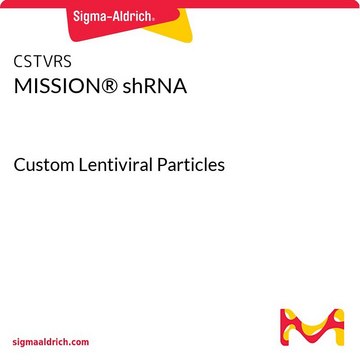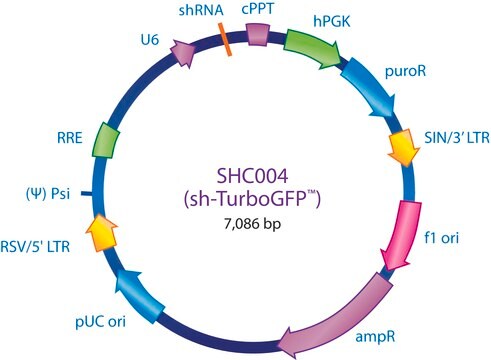SHC332
MISSION® 3X LacO Inducible Non-Target shRNA Control Plasmid DNA
Does not target any known genes
Sinónimos:
MISSION® Control Vectors
Iniciar sesiónpara Ver la Fijación de precios por contrato y de la organización
About This Item
Productos recomendados
product line
MISSION®
concentration
500 ng/μL in TE buffer; DNA (10μg of plasmid DNA)
shipped in
dry ice
storage temp.
−20°C
¿Está buscando productos similares? Visita Guía de comparación de productos
Categorías relacionadas
General description
Sigma® is proud to offer IPTG-inducible vectors as the latest development from our continued partnership in TRC.
The pLKO vector has been redesigned to contain a LacI (repressor) and a modified human U6 shRNA promoter with LacO (operator) sequences. In the absence of IPTG (isopropyl-Β-D-thio-galactoside), an analogue of lactose, LacI binds to LacO preventing expression of the shRNA. When IPTG is present, the allosteric LacI repressor changes conformation, releasing itself from lacO modified human U6 promoter, and subsequently allows expression of the shRNA.
We are proud to offer two different IPTG inducible vectors for your research. The preferred inducible vector, pLKO_IPTG_3xLacO, contains three lac operon sequences (two in the U6 promoter and one 3′ of the promoter) affording both tight regulation and great gene silencing. Whereas, the pLKO_IPTG_1xLacO vector contains a single lac operon sequence in the U6 promoter, which allows for an advantage to shRNA expression, but looser control of the promoter when not induced.
The MISSION® 3X LacO Inducible Non-Target shRNA Control is a lentivirus plasmid vector. The vector contains an shRNA insert that does not target any known genes, making it useful as a negative control in experiments using the MISSION inducible shRNA library clones. This allows one to examine the effect of transfection of a short-hairpin on gene expression and interpret the knockdown effect seen with shRNA clones. Ampicillin and puromycin antibiotic resistance genes provide selection in bacterial or mammalian cells respectively. In addition, self-inactivating replication incompetent viral particles can be produced in packaging cells (HEK293T) by co-transfection with compatible packaging plasmids. The 1X LacO Inducible Non-Target shRNA Control is provided as 10 μg of plasmid DNA in Tris-EDTA (TE) buffer at a concentration of 500 ng/μl.
The pLKO vector has been redesigned to contain a LacI (repressor) and a modified human U6 shRNA promoter with LacO (operator) sequences. In the absence of IPTG (isopropyl-Β-D-thio-galactoside), an analogue of lactose, LacI binds to LacO preventing expression of the shRNA. When IPTG is present, the allosteric LacI repressor changes conformation, releasing itself from lacO modified human U6 promoter, and subsequently allows expression of the shRNA.
We are proud to offer two different IPTG inducible vectors for your research. The preferred inducible vector, pLKO_IPTG_3xLacO, contains three lac operon sequences (two in the U6 promoter and one 3′ of the promoter) affording both tight regulation and great gene silencing. Whereas, the pLKO_IPTG_1xLacO vector contains a single lac operon sequence in the U6 promoter, which allows for an advantage to shRNA expression, but looser control of the promoter when not induced.
The MISSION® 3X LacO Inducible Non-Target shRNA Control is a lentivirus plasmid vector. The vector contains an shRNA insert that does not target any known genes, making it useful as a negative control in experiments using the MISSION inducible shRNA library clones. This allows one to examine the effect of transfection of a short-hairpin on gene expression and interpret the knockdown effect seen with shRNA clones. Ampicillin and puromycin antibiotic resistance genes provide selection in bacterial or mammalian cells respectively. In addition, self-inactivating replication incompetent viral particles can be produced in packaging cells (HEK293T) by co-transfection with compatible packaging plasmids. The 1X LacO Inducible Non-Target shRNA Control is provided as 10 μg of plasmid DNA in Tris-EDTA (TE) buffer at a concentration of 500 ng/μl.
Application
To see more application data, protocols, vector maps visit sigma.com/shrna.
Legal Information
Use of this product is subject to one or more license agreements. For details, please see http://sigmaaldrich.com/missionlicense.
MISSION is a registered trademark of Merck KGaA, Darmstadt, Germany
Sigma is a registered trademark of Sigma-Aldrich Co. LLC
Optional
Referencia del producto
Descripción
Precios
Storage Class
12 - Non Combustible Liquids
wgk_germany
WGK 1
flash_point_f
Not applicable
flash_point_c
Not applicable
Certificados de análisis (COA)
Busque Certificados de análisis (COA) introduciendo el número de lote del producto. Los números de lote se encuentran en la etiqueta del producto después de las palabras «Lot» o «Batch»
¿Ya tiene este producto?
Encuentre la documentación para los productos que ha comprado recientemente en la Biblioteca de documentos.
Los clientes también vieron
Daniel J Puleston et al.
Cell metabolism, 30(2), 352-363 (2019-05-28)
How cells adapt metabolism to meet demands is an active area of interest across biology. Among a broad range of functions, the polyamine spermidine is needed to hypusinate the translation factor eukaryotic initiation factor 5A (eIF5A). We show here that
Polyamines Control eIF5A Hypusination, TFEB Translation, and Autophagy to Reverse B Cell Senescence.
Hanlin Zhang et al.
Molecular cell, 76(1), 110-125 (2019-09-03)
Failure to make adaptive immune responses is a hallmark of aging. Reduced B cell function leads to poor vaccination efficacy and a high prevalence of infections in the elderly. Here we show that reduced autophagy is a central molecular mechanism
Swapna Aravind Gudipaty et al.
Molecular and cellular biology, 35(22), 3810-3828 (2015-09-02)
Transcription elongation programs are vital for the precise regulation of several biological processes. One key regulator of such programs is the P-TEFb kinase, which phosphorylates RNA polymerase II (Pol II) once released from the inhibitory 7SK small nuclear ribonucleoprotein (snRNP)
Nuestro equipo de científicos tiene experiencia en todas las áreas de investigación: Ciencias de la vida, Ciencia de los materiales, Síntesis química, Cromatografía, Analítica y muchas otras.
Póngase en contacto con el Servicio técnico








